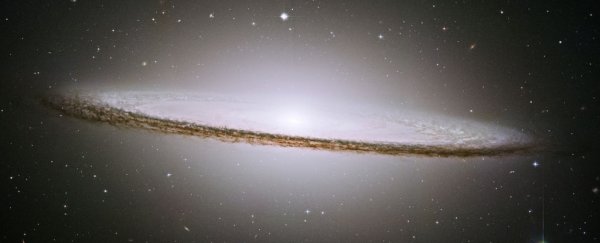Compared to our brief human lives, we tend to think of events on galactic scales as ones that happen extremely slowly. But that's not always the case.
In a spectacular fashion, six galaxies have just undergone a huge transformation in a matter of mere months. They've gone from relatively peaceful galaxies to active quasars - the brightest of all galaxies, blasting vast amounts of radiation out into the Universe.
This isn't just amazingly cool - these events could help to resolve a long-standing debate about what produces the light in a particular type of galaxy. In fact, they may indicate a previously unknown type of galactic nucleus activity.
The six galaxies started out as low-ionisation nuclear emission-line region (LINER) galaxies; in terms of brightness, that's sort-of like being a galactic middle child.
Making up a third of all known galaxies, they're brighter than ones with dormant supermassive black holes at the centre, but not as bright as active galaxies (known as Seyfert galaxies), whose supermassive black holes are chowing down on cosmic snacks.
Now, quasar galaxies are the brightest of such active galaxies; in fact, they are among the brightest objects in the Universe. The light and radio emissions we see are caused by material around the black hole, called an accretion disc.
That disc contains dust and gas swirling at tremendous speeds like water going down a drain, generating immense friction as it's pulled by the massive gravitational force of the black hole in the centre. This friction produces intense heat and light; vast jets spewed from the black hole's polar regions emit radio waves.
Meanwhile, there's been a long-standing debate over what exactly produces light in LINER galaxies. Some astronomers believe it's produced by black holes; others think that it's the result of copious starburst activity - that is, lots of stars being born.
But, when a team of astronomers led by astronomer Sara Frederick of the University of Maryland went over the first nine months' worth of data from the Zwicky Transient Facility automated sky survey, they found six LINER galaxies doing something… odd.
"For one of the six objects, we first thought we had observed a tidal disruption event, which happens when a star passes too close to a supermassive black hole and gets shredded," Frederick said.
"But we later found it was a previously dormant black hole undergoing a transition that astronomers call a 'changing look,' resulting in a bright quasar. Observing six of these transitions, all in relatively quiet LINER galaxies, suggests that we've identified a totally new class of active galactic nucleus."
Changing-look transitions are not uncommon, but nor are they usually this dramatic. The first changing-look quasar, in fact, wasn't reported until 2015, and then it was in the opposite direction - a quasar dimming into a Seyfert galaxy.
Moreover, such changing-look transitions are usually observed occurring between different types of Seyfert galaxies, which produce different types of light. This light usually depends on the orientation of the galaxy - edge-on, or with the full disc facing us - so these transitions are a mystery unto themselves (and hopefully to be explained another day).
These Seyfert transitions were what the team set out to study.
"Instead, we found a whole new class of active galactic nucleus capable of transforming a wimpy galaxy to a luminous quasar," said astronomer Suvi Gezari of the University of Maryland.
"Theory suggests that a quasar should take thousands of years to turn on, but these observations suggest that it can happen very quickly. It tells us that the theory is all wrong. We thought that Seyfert transformation was the major puzzle. But now we have a bigger issue to solve."
None of the galaxies have particularly active star formation - the most active is producing the equivalent of 1.27 Suns every year. Other surveys have revealed that many (but certainly not all) LINER galaxies don't seem to have high star formation rates, too.
That doesn't mean that the six galaxies are indicative of all LINER galaxies with low star formation. It could mean that they are a different class of galaxy altogether.
But the findings also mean that what we knew about quasars could be wrong, too. The fact that these galaxies could change so dramatically so quickly - on human timescales - is inconsistent with current quasar theory. Whatever can cause such an extreme change must be pretty intense.
"These six transitions were so sudden and dramatic, it tells us that there is something altogether different going on in these galaxies," Frederick said.
"We want to know how such massive amounts of gas and dust can suddenly start falling into a black hole. Because we caught these transitions in the act, it opens up a lot of opportunities to compare what the nuclei looked like before and after the transformation."
Intriguing.
The research has been published in The Astrophysical Journal.
